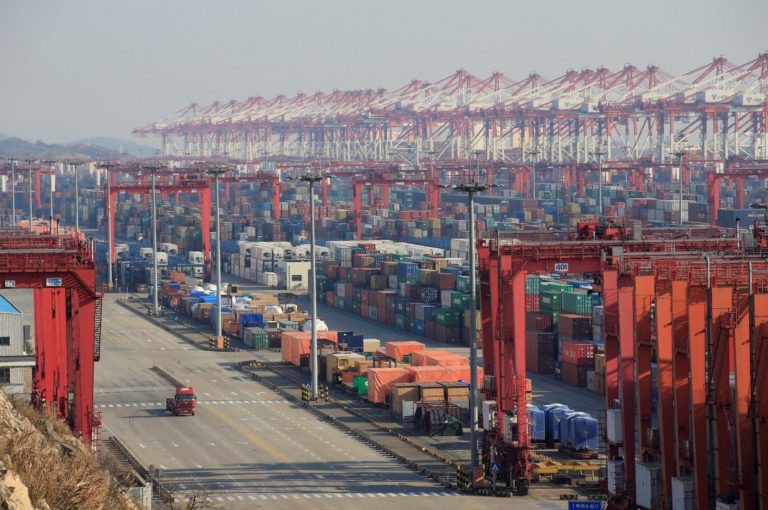China’s export growth falters, imports shrink as demand wanes
BY AGENCIES

China’s exports and imports lost momentum in August with growth significantly missing forecasts as surging inflation crippled overseas demand and fresh anti-virus curbs and heat waves disrupted output, reviving downside risks for the shaky economy.
Exports rose 7% over a year ago to $314.9 billion, barely one-third of July’s 18% expansion, customs data showed Wednesday. It came in well below analysts’ expectations for a 12.8% increase.
Imports contracted by 0.2% to $235.5 billion, compared with the previous month’s already weak 2.3% growth, and well below a forecast for a 1.1% rise. Both imports and exports grew at their slowest pace in four months.
Outbound shipments have outperformed other economic drivers this year but now face growing challenges as demand for Chinese exports has softened as economic activity in Western markets slowed and the U.S. Federal Reserve (Fed) and central banks in Europe and Asia raise interest rates to cool surging inflation. At home, repeated closures of cities to fight virus outbreaks has weighed on consumer spending.
“It seems the export softness arrived in earlier than expected, as recent shipping data suggests that demand from the U.S. and EU has already slowed as shipping prices have been falling significantly,” said Zhou Hao, chief economist at Guotai Junan International.
He expects pricing effects will continue to disrupt trade and said import growth in real terms had already turned negative since the late first quarter, suggesting more headwinds for demand.
“The slowdown in China’s export sector is adding to headwinds for the Chinese economy,” said Rajiv Biswas of S&P Global Market Intelligence in a report. The lack of import growth highlights the “continued weakness of Chinese domestic demand.”
The weakening yuan, which recently hit two-year lows, has not boosted China’s export growth, highlighting the subdued external demand.
The slower growth is in part due to unflattering comparisons to strong exports last year, but also worsened by more COVID-19 restrictions as infections spiked and heat waves disrupted factory output in southwestern areas.
Growth in the world’s second-largest economy fell to 2.5% in the first half of 2022, less than half the ruling Communist Party’s 5.5% annual target, after Shanghai and other industrial centers were shut down to fight virus outbreaks.
The International Monetary Fund (IMF) and private sector forecasters have trimmed their already low growth forecasts.
Factories have reopened, but temporary closures in areas including the southern business center of Shenzhen and a dry summer that left reservoirs in China’s southwest unable to generate hydropower have weighed on activity.
Export hub Yiwu imposed a three-day lockdown in early August to contain a COVID-19 outbreak, disrupting local shipments and delivery of Christmas goods amid the peak season.
The weak domestic demand, dampened by the worst heatwaves in decades, a property crisis and sluggish consumption, crippled imports.
Global commodity prices continued to fall in August, though at a slower pace.
“The remarkably slower imports growth indicated the sector has faced a wave of headwinds in recent months, which is not expected to ease anytime soon,” said Bruce Pang, a chief economist at Jones Lang Lasalle.
“COVID outbreaks disrupted supply chains and demand, while the power rationing measures hurt production. The broad dollar strength also brings pressure on imports.”
This left a narrower trade surplus of $79.39 billion, compared with a $101.26 billion surplus in July, which was a record for a single-month goods trade balance for any country in history.
Analysts at Goldman Sachs expect China’s large trade surpluses to sustain over the next few years but warned key risks are geopolitical tensions and substantially higher commodity prices over the medium-term.
Assistant Commerce Minister Li Fei said on Monday that China’s foreign trade faces unfavorable factors, including weakening external demand.
The central bank on Monday said it would cut the amount of foreign exchange reserves financial institutions must hold, a move aimed at slowing the yuan’s recent depreciation.
By: DAILY SABAH
Recent Posts
- By: admin
- Date: March 2, 2023
Turkish Technic to provide free maintenance for global airlines flying to quake zone
- 4 min read
- 0 comment
Turkish Technic to provide free maintenance for global airlines flying to quake zone BY ANADOLU AGENCY | ANKARA Turkish Technic provides maintenance services without labor...
- By: admin
- Date: February 8, 2023
Fire extinguished at Türkiye’s quake-hit Iskenderun port
- 4 min read
- 0 comment
Fire extinguished at Turkey’s quake-hit Iskenderun port BY REUTERS | ISKENDERUN, TÜRKIYE Smoke rises from burning containers at the port in the earthquake-stricken town of...
- By: admin
- Date: January 19, 2023
Turkey aims to link Istanbul, Sabiha Gökçen airports with high-speed train
- 6 min read
- 0 comment
Turkey aims to link Istanbul, Sabiha Gökçen airports with high-speed train BY DAILY SABAH | ISTANBUL Passengers are seen at Istanbul Airport, in Istanbul, Türkiye,...
